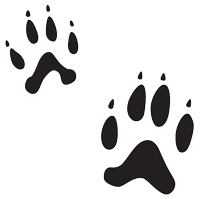
16 September 2015
“Best Mammal” on my trip to Maine was an animal with three or four names but I don’t know which ones until I identify him — and that’s mighty hard to do, even for professionals.
While puttering around the South Lubec sand flats looking for shorebirds, I noticed animal prints in the damp sand. They were almost the size of cat prints but the toes showed claws and the prints weren’t using direct register (hind prints stepping into front prints). They looked sort of like this:

I guessed weasel but not necessarily the short-tailed weasel illustrated here. It may have been a long-tailed weasel. (Click here to see his prints.)
On my way out I saw a weasel cross the dirt track ahead of me and disappear into tall weeds. He was a long russet-colored mammal about the size of a red squirrel with short round ears, stubby legs, and a long black-tipped tail. His tail was at least as long as his body.
“Size of red squirrel” says short-tailed weasel. “Long-as-body tail” says long-tailed weasel, shown below(*).

With such a short glimpse I can identify him generally but not specifically. His genus is weasel (Mustela), his species is either short-tailed (Mustela erminea) or long-tailed (Mustela frenata). The two are notoriously hard to tell apart. I’ll never know for sure.
No matter what he is he will soon shed his brown fur and turn white to match the winter landscape. If he’s a short-tailed weasel (erminea) you’ll recognize him as the ermine or stoat that’s native to Eurasia and North America. His long-tailed North American cousin is just larger.
I’d like to see this weasel in his winter clothes but I’m not going to Maine in winter to find him.
(photos from Wikimedia Commons. Weasel tracks linked from National Park Service Yellowstone. Click on the image to see the original)
(* I didn’t take his picture — these photos are from Wikimedia Commons — so I had to rely on my memory. Luckily least weasels don’t live in Maine so that narrows it to 2 possibilities.)
